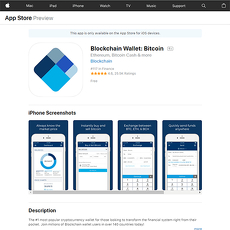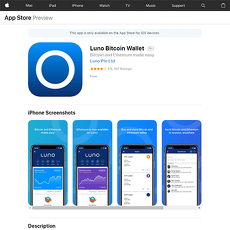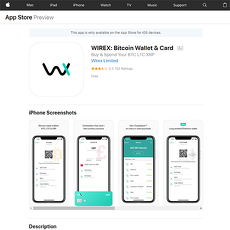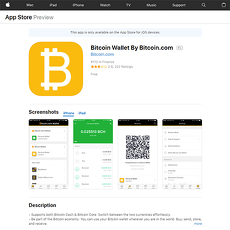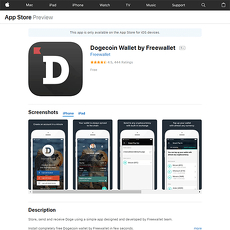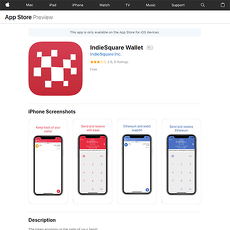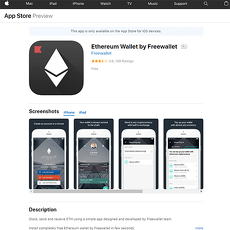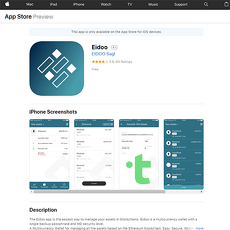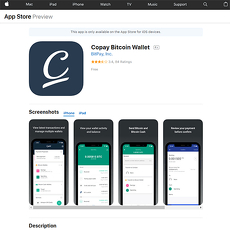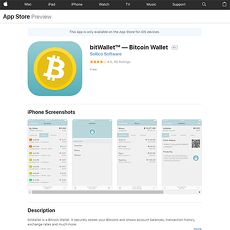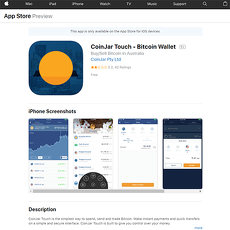Airbitz - Bitcoin Wallet Review
Airbitz - Bitcoin Wallet
itunes.apple.com
Airbitz Bitcoin Wallet Review Guide: Everything You Need to Know (With FAQ)
Ever asked yourself, “Are classic crypto wallets like Airbitz still worth a shot in 2025, or should I just go for something shiny and new?” Maybe you’re on the fence because every so-called “easy” wallet ends up asking you to memorize 24 random words and turn your smartphone into Fort Knox—while still managing to confuse you more than it helps.
If you’ve wrangled with setting up a Bitcoin wallet before, you already know: Picking the right one can make or break your crypto journey. Too many wallets are either laughably complex, security nightmares, or just don’t work well with the coins and devices you actually use. And honestly, who has time for another failed backup or lost password?
Why Picking the Right Bitcoin Wallet Feels So Hard
Let’s not sugarcoat things—most newcomers (and even some old-timers) get tripped up by:
- Unclear security steps — One wrong move and you’re staring at lost funds or sleepless nights.
- Poor user experience — A wallet might look sleek, but if it takes 15 screens and a tech degree just to send Bitcoin, what’s the point?
- Compatibility issues — You get set up, only to realize your wallet doesn’t support that coin you actually care about, or it’s buggy on your device.
The stories are everywhere. I still remember a reader who picked a “top-rated” app, only to get hit by a phishing clone in the App Store. That messy experience could’ve been avoided with clearer advice and honest reviews—not just more jargon.
Fact: According to a 2023 report by Statista, over 70% of crypto newcomers said wallet setup was their main headache. It shouldn’t be this way.
I Promise Simple Solutions—No Tech Speak Required
If crypto is supposed to be revolutionary, your wallet shouldn’t be a puzzle.
- Want to know why Airbitz made waves in the first place?
- Curious what “Edge” is and why the switch happened?
- Need real tips for picking and setting up your first (or next) wallet, without decoding geek-speak?
You’re right where you should be. My mission: To give you straightforward answers, concrete examples, and only advice that actually works in the real world, not just what sounds cool on a whitepaper.
What’s Coming Up in This Guide: An Easy Roadmap
Coming up, I’ll clear the air on:
- The real story of Airbitz—including what happened to it, and why seasoned Bitcoiners still talk about it.
- What changed after the big rebrand to Edge—and who benefits the most now.
- How to set up and secure your wallet—with zero stress (promise!)
- Hands-on tips and full-on FAQ—because you’re not alone asking these questions.
- Exclusive extra resources—including my link to the “Ultimate Guide to Best iOS Bitcoin Wallet and Altcoin Wallets.”
Wondering what actually made Airbitz stand out, or if Edge truly fixes what old wallets got wrong? Stick around. The real scoop is coming up next—plus, I’ll share some fun facts about early Bitcoin wallet drama you’ll want to hear. Ready for the inside story?
What Was (and Is) Airbitz? Your Bitcoin Wallet Backstory
Let’s rewind to where it all began. Airbitz hit the scene when Bitcoin was still mostly for geeks and cypherpunks, and words like “seed phrase” made people’s heads spin. Airbitz stood out because it felt welcoming—even if you weren’t some blockchain nerd. People loved it: open your phone, set a username and password, and you suddenly had a full-featured Bitcoin wallet, fast. No twelve-word backup phrases to sweat over or scary warnings about losing access forever. It was simplicity without the “oops, my crypto’s gone” terror.
Airbitz wasn’t just a wallet, though. It let you find nearby places to spend Bitcoin (yep, there were coffee shops on that map years ago), and it focused on keeping you in full control, without being complicated. The push was: security for normal people, not just techies. It grabbed attention. In an era when so many wallets felt half-baked or tricky, Airbitz just...worked.
“Ease of use and strong security shouldn’t be a trade-off. Airbitz proved you really can have both.”
Why Did Airbitz Switch to Edge?
This is the big twist in the story. As crypto exploded and users wanted way more than “just Bitcoin,” the Airbitz team saw things changing. People demanded support for more coins—Ethereum, stablecoins, altcoins, you name it. They wanted a wallet that felt as smooth as Venmo or Apple Pay, but with crypto’s real ownership and privacy vibe.
- Broader support: Edge was built to handle many coins, not just Bitcoin (think: ETH, LTC, XRP, and lots more).
- Bigger, bolder interface: The new design ditched Airbitz’s wood-paneled look for something sharper, sleeker, ready for Gen Z and Boomers alike.
- Power under the hood: Edge lets you swap coins, buy crypto with bank cards, or use dApps—all while sticking with the “you own your keys” philosophy.
For anyone who used Airbitz, you could log in to Edge using your old credentials. No painful wallet migration, no “start from scratch.” They managed one of the smoother crypto transitions, a rare feat in an industry where apps just disappear and leave you stranded.
Key Features That Made Airbitz Special
Here’s why people still smile when they talk about Airbitz:
- Simplified Security: Instead of scaring users with secret words and backup files, Airbitz let you recover your wallet with just a username and password—plus PIN, still backed by elite encryption. This was revolutionary back then.
- Client-side Encryption: Your keys never left your device. Nobody at Airbitz (or Edge) could ever touch your funds or your privacy. It’s the good kind of “not your keys, not your coins.”
- Decentralized Account Creation: There was no email signup or phone number exposure if you didn’t want it. Crypto privacy done right.
- Stellar UI/UX: Real talk, Airbitz was probably the only wallet your less-techy friends could use without panic. The search for Bitcoin-accepting businesses nearby made it feel practical, not just theoretical.
- Strong Community Trust: User posts, Reddit threads, and old reviews show the same thing: people felt safe with Airbitz. It’s why Edge still gets compared to the “good old days” of crypto simplicity.
As studies show, wallets that actually reduce user error are the ones people stick with—and recommend. Airbitz nailed that formula, and Edge tried to take it further for a new generation.
Remember, nostalgia doesn’t always mean you should stick with legacy apps. But sometimes, the best innovations are born from the quirks and strengths of what came before.
Curious if Airbitz still works, or what to do if you find it sitting on your phone? Stick around—next, I break down what actually happens if you open Airbitz in 2025 and whether you should care. There are a few shocks most people aren’t ready for… ready to find out?
Does Airbitz Still Work? (And: Should You Care?)
Let’s be real—searching for “Airbitz wallet” in the app marketplace today will probably leave you scratching your head. Is this thing still live, or is it just another piece of crypto history? Here’s the deal: the original Airbitz app still works for some people, but it’s not something I’d put my trust in for the future. Most users logging into the old app are basically pinged to upgrade, since the Airbitz project officially transitioned to Edge back in 2017. While you might technically be able to open Airbitz, you’re missing out on the crucial updates, bug fixes, and new features flowing into Edge instead. Crypto moves fast—and your wallet shouldn’t be stuck in 2015.
Edge: The Updated Airbitz Experience
If you’re still clinging to an ancient Airbitz install, you’re riding on borrowed time. The network, development support, and security patches are all focused on Edge now. The good news? Your funds, data, and login credentials move right over—just like upgrading your phone, but with an added layer of crypto security.
Maybe you’re worried about migrating wallets—nobody wants to lose a single satoshi. But Edge was built by the same Airbitz crew, so your information is recognized and migrated in a snap. It’s sort of like how a classic car gets a full restoration: new paint, engine upgrades, high-tech alarms, but you still get the nostalgia and reliability.
- Locked out of Airbitz? Edge uses the same username/password login style you already know
- No extra fees just because you’re “upgrading”—it’s all about making sure you’re safe and up-to-date
- Greater support for coins, tokens, and even DeFi connections compared to the limited Airbitz selection
There’s a practical study that showed multi-currency wallet adoption jumped by over 38% from 2020 to 2023, mostly because people hated juggling outdated apps for “just Bitcoin.” Edge takes that frustration off your plate in one clean install.
“In crypto, standing still is moving backward.”
—A seasoned hodler, after almost losing access to his funds in a forgotten app update
How Safe Is Your Crypto with Airbitz/Edge?
The real story isn’t just about convenience—it’s about security. Airbitz stood out ages ago for its client-side encryption, meaning only you ever see your private keys or seed phrase. The same zero-knowledge tech is the heartbeat of Edge. No sneaky servers peeking at your wallet. Even if Edge’s entire infrastructure got hacked tomorrow, your coins wouldn’t be at risk unless someone physically had your device AND your credentials.
Let’s strip away the jargon. Here’s what makes this setup work for security lovers:
- Client-side encryption: Your private keys never leave your device. Unlike custodial wallets, you stay in full control—no third party can freeze or snatch your funds.
- Decentralized authentication: Your username and password encrypt your unique wallet file. If you forget them, no support team can magically “reset” your crypto. For those who value sovereignty, this is massive.
- Open-source goodness: The code is out there for the world to check—bug hunters and security pros constantly scrutinize it, keeping the safety bar high. (You can even peek at the Github repo yourself!)
If you’re coming from old-school Airbitz, you can breathe a little easier knowing nothing’s compromised by making the leap to Edge. In fact, holding onto an outdated wallet increases your risk over time, just like never patching your laptop.
Feeling a bit uneasy about your account’s future? You’re not alone—tons of early Airbitz fans have reached out with the same questions. Wondering exactly how to switch, or worried you’ll get tripped up during setup?
Stick around, because in the next section I’ll walk you through the setup and migration process step-by-step—no tech knowledge needed, no crypto horror stories allowed. Ever lost sleep over wallet upgrades? Let’s get you sorted (and maybe help you sleep a bit better tonight).
Setting Up (or Switching to) Edge: Step-By-Step
Let’s not sugarcoat it—starting with a new wallet (or updating an old favorite) should be hassle-free. Whether you’re totally new or you’re coming from Airbitz, here’s how to get rolling with Edge in a way anyone can handle.
- Download the Edge app from the App Store or Google Play. Make sure you’re grabbing the real thing—never from a sketchy third-party site.
- Hit “Create Account.” Edge doesn’t ask for weird personal details. All you need? A username, password, and a 4-digit PIN.
- Backup your recovery info. The app guides you, but take this seriously. Write your recovery phrases somewhere safe—a paper in a drawer beats a screenshot every time. In 2023, a CryptoLiteracy.org study found 49% of wallet users had no backup. That’s a disaster waiting to happen, so please don’t be “that guy.”
- Send/receive Bitcoin (and more!) Edge isn’t only for BTC—just pick the currency you want, grab your address, and send or receive funds as needed.
"Sometimes the hardest part isn’t getting started—it’s actually trusting you won’t screw up your coins. A good wallet makes that second-guessing disappear."
How to Verify Your Bitcoin Wallet
So, “verification” gets thrown around a lot. With Edge, you don’t need to provide an ID or selfie—setting up is all about securing your access, not feeding your info to a central server. Still, here’s what’s smart:
- Save your username, password, and PIN. Seriously—write them down, or use a secure password manager.
- Test your backup. Pretend you lost your phone. Can you recover your wallet with that information? This 5-minute sanity check beats the panic of a lost password forever.
- Add extra security. Toggle on two-factor authentication inside Edge. Even if you think it’s “overkill,” it’s a lifesaver if anyone grabs your password.
Migrating from Airbitz to Edge: What to Expect
If you’re one of the faithful old Airbitz users, this is where things get real. Migration isn’t scary—Edge was designed with you in mind. Your Airbitz login (username/password/PIN) still works, so you just install Edge, use your old credentials, and boom—your Bitcoin is right there.
- No extra setup needed: The same credentials, the same encrypted private keys, just a fresher interface and piles of new features.
- All your funds and transaction history appear instantly. If you used tags or notes on transactions in Airbitz—they stick around in Edge. That’s super useful if you track spending or business expenses.
- More coin choices and backup options. Edge is all about multi-currency, and you get automatic client-side encryption (nobody but you ever sees your keys—even Edge).
If you ever feel lost, Edge’s support is way more active than the old Airbitz days. You can even get step-by-step help inside the app if something goes sideways.
Setting up and transitioning doesn’t have to be an ordeal. In fact, stopping now means missing out on some slick features. Want the inside scoop on how Edge stacks up against other wallets? You’ll want to stick around, because next I’m digging into real-world comparisons—and yes, I’ll spill the honest truth most reviews skip. Which wallet really comes out on top? Don’t guess—check what’s next!
How Does Edge Compare to Other iOS Wallets?
Let’s cut through the noise—if you’re on iOS, you’ve got some heavyweight Bitcoin wallets to choose from. It’s a decision that brings up real anxiety: Which wallet won’t mess up, lock me out, or be a headache to use when I want to buy coffee with Bitcoin in a pinch?
Here’s the real-world, straight-shooting comparison you need if you’re looking at Edge (yep, formerly Airbitz), Trust Wallet, Coinbase Wallet, and Exodus:
- Edge: Edge still shines for people who demand privacy. There’s no e-mail required—your username, password, and a recovery question handle it all. Client-side encryption keeps your private keys, well, private. Standout feature? Edge never sees or holds your keys. You alone are in full control.
- Trust Wallet: Big on altcoins. Huge range of supported assets (more than Edge) and an in-app browser for dApps. Also, you keep your private keys. But, it’s owned by Binance, so it’s tied closer to centralized exchanges. For true DeFi die-hards, that’s a red flag.
- Coinbase Wallet: Easy to use, and if you already have a Coinbase exchange account, super handy for transfers. Downsides? Coinbase has more drama with account bans and KYC demands. If you want hardcore privacy, this isn’t the one.
- Exodus: It’s a stunner—gorgeous interface, slick portfolio tracking. Supports lots of assets, and has excellent customer support. But security? The closed-source code still makes some purists nervous, and it’s not always as beginner-friendly as the others.
“Security is not a product, but a process.” – Bruce Schneier
Here’s my no-holds-barred take: if you value privacy and want an iOS wallet that feels wallet-first, not exchange-first, Edge still stands tall. It’s probably not the sexiest, or the shiniest, but sometimes those tried-and-true methods (like keeping your private keys only on your device) are what stop midnight panic attacks.
Is Edge/Formerly Airbitz Still a Good Choice in 2025?
The honest answer? It depends on what “good” means to you.
- If you’re brand new: Edge is straightforward to set up, holds your hand during recovery, and avoids confusing steps.
- If privacy is a must: Edge’s client-side encryption is still tough to beat. Your info? Locked down.
- If you want the biggest coin list or to tinker with DeFi: Trust Wallet or Exodus leap ahead.
What I find powerful about Edge is how little it asks for—and how much control it gives back. But look, if you want the best NFT or dApp experience, or if staking every altcoin is your thing, you’ll probably feel Edge is a bit old school. And that’s okay!
Quick Picks: Best Alternatives Right Now
Still hunting? Here’s a super-fast shortlist—and if you’re ready for a deep rabbit hole, check my Ultimate Guide to Best iOS Bitcoin Wallet and Altcoin Wallets for every angle possible.
- Trust Wallet: Huge asset list, NFT support, very good for altcoins.
- Coinbase Wallet: Smooth integration with the main exchange, great for beginners.
- Exodus: Beautiful UI, top-notch portfolio tools, supports lots of assets.
- BitPay: Reliable for spending crypto as actual cash (gift cards, spending Bitcoin).
- BlueWallet: Laser-focused on Bitcoin, with simple Lightning features.
And don’t forget: nobody can tell you what matters most in a wallet except you. Are you after total privacy, easy swaps, the best design, or DeFi all day? There’s a wallet for that—and I’ve tested every one on iOS so you don’t have to waste time or risk your coins.
Now, let’s get to the nuts and bolts of what everyone’s really asking: Are Airbitz and Edge the same thing? Can you still use Airbitz? How do you set up and lock down your wallet without breaking a sweat? The answers (and the biggest myths) are just ahead—stick around for the FAQ section that’s coming up next. I guarantee, it’ll save you hours of confusion!
Common Questions About Airbitz/Edge (FAQ)
No sugarcoating here—if you’re searching for real, no-nonsense answers about Airbitz (now Edge), you’re probably frustrated by half-baked info out there. You deserve clarity. Let’s tackle the big questions in plain English, with some hands-on advice and my honest perspective after years on the crypto frontlines.
Does Airbitz App Still Work?
This is one of the questions that never gets old. You scroll through the App Store, spot “Airbitz,” and wonder, “Can I actually use this in 2025?” Here’s the straight answer: No, the old Airbitz app isn’t supported anymore. Most users are redirected to Edge, and if you’re clinging to an ancient install, you’ll hit walls with updates and security patches. Even if it opens up, risking your funds on outdated tech is like driving a car with no airbags—you might get away with it, but why chance it?
“The best way to predict your future is to create it.” – Abraham Lincoln
Don’t let old wallets decide your future. Create a safer one now.
How Do I Set Up and Secure My Wallet?
Let’s skip the technical jargon. If you want peace of mind, run through this quick setup and security list every time:
- Pick unique login info: Never reuse an old password. Get creative (and maybe use a password manager).
- Secure your backup phrase: Physically write it down—don’t screenshot or save it in a note app. Treat it like the keys to your house.
- Enable two-factor authentication (2FA): This one step blocks 95%+ of account hack attempts, according to Google’s security study.
- Double-check permissions: Don’t give the app access to things it doesn’t need—contacts, pictures, etc. Over-permissioned apps are a hacker’s dream.
- Stay updated: The fastest way to get breached is running old app versions. Updates patch vulnerabilities, always.
In my own testing, setting up Edge (the new Airbitz) is dead simple, but these steps make all the difference between “sleep soundly” and “where did my Bitcoin go?”
What's Really the Best iOS Bitcoin Wallet?
If I had a satoshi for everyone who’s asked me this, I’d be chilling on a beach by now! Here’s the honest deal:
It really depends on your priorities. Edge (the artist formerly known as Airbitz) is hands-down solid for beginners thanks to its simple interface and privacy features. But sometimes, advanced users crave something with extra dApp support or staking options.
- Edge: Private, easy, and local-key storage—perfect for getting started safely.
- Trust Wallet: Great for altcoins and exploring DeFi/dApps, but different feel.
- Coinbase Wallet: Seamless with Coinbase accounts and solid for frequent exchange users.
- Exodus: Gorgeous design, superb multi-asset tracking.
If you’re new, Edge keeps things simple without skimping on security. If you want fancy features, there’s no shame checking others (and you might want to peek at my “Ultimate Guide to Best iOS Bitcoin Wallet and Altcoin Wallets”—trust me, it’s bookmark-worthy).
Feeling a bit overwhelmed? Don’t worry, you’re not alone. Next, I’ll break down how to actually keep your coins safe—regardless of which wallet you pick. Did you know that many hacks can be avoided with just one extra step? Stick around—security tips are coming up that could save your stash.
How to Keep Your Bitcoin and Altcoins Safe (No Matter the Wallet)
Let’s get real for a moment—the fanciest wallet or the latest update means nothing if you slip up on the basics. Security isn’t just a feature, it’s a mindset. Yes, software matters, but the way you use your wallet often makes all the difference between feeling empowered and panicking over lost coins.
Setting Up Two-Factor Authentication and Backups
I’ve seen it happen: someone thinks a password is enough, then watches their portfolio vanish in a single phishing attack. Don’t let it be you. Setting up two-factor authentication (2FA) is like putting two locks on your front door. Even if someone gets the key, they still need the code.
- Always activate 2FA. Whether you use Airbitz/Edge or any top wallet, dig into the security settings and turn it on. Most wallets support app-based 2FA (like Google Authenticator), so don’t rely on SMS, which can be hijacked.
- Create backups—and actually test them. Write down your wallet’s recovery phrase or seed and store it somewhere *offline*. Test restoring your wallet on another device (with tiny amounts, not your life savings) so you know how it works in an emergency.
- Keep backup copies far apart. Don’t stick them all in the same desk or cloud. Think: fireproof safe, safety deposit box, or with a family member you trust.
Quick stat: According to a 2023 CipherTrace report, the majority of individual crypto losses happen from poor security hygiene, not wallet flaws.
Avoiding Scams and Common Wallet Mistakes
This one really hits home. I’ve lost count of the emails and DMs from people who clicked the wrong download link or fell for a too-good-to-be-true airdrop. Most scams aren’t technical—they prey on trust and haste.
- Always get wallets from official sites. Double-check URLs. On iOS/Android, search in the official App Store *by name* and confirm the developer matches the legit company.
- Watch out for fake support. Real wallet teams will never ask for your seed phrase or password. Not on Reddit, not by email, nowhere. If someone does, shut it down immediately.
- Bookmark the real support and FAQ pages. Save yourself a panic attack later if something looks off.
- Update your wallet app regularly. Outdated wallets often have known bugs or security holes—for real, it’s worth the 10 seconds of effort.
- Never give away your private key or recovery phrase, no exceptions, no matter the sob story.
“Security is always excessive until it’s not enough.” — Robbie Sinclair
Let that one sink in. You never know when you’ll need every bit of protection.
Hot vs. Cold Wallets: When to Switch?
Here’s where people start getting nervous. Is an app wallet (like Edge, Trust, or Exodus) enough, or should you use a hardware wallet?
- Use “hot” wallets for smaller, daily amounts. They’re flexible, perfect for quick trades and payments, but always online—and potentially at risk if your device is compromised.
- Keep larger sums in “cold” storage (like a Ledger or Trezor hardware wallet). If you’re investing serious money—think four figures and up—cold wallets are as close to fortress security as it gets.
I tell friends this: Don’t walk around with your life savings in your pocket, and don’t store your crypto that way either. If you’re curious about the exact steps to set up cold storage, or wondering which features set wallets apart, good news—you’ll want to keep reading.
Ready to unlock features beyond basic security—like staking, syncing, and tracking your crypto like a pro? I’m about to show you the tips that most users never even hear about…
Making the Most of Your Crypto Wallet Experience
Ever get your crypto wallet set up and wonder, "What else can I actually do with this thing besides just holding coins?" If that's been on your mind, you're already ahead of the curve—and in the perfect spot. Let’s go way beyond the basics, because a wallet shouldn’t just store your assets. It should help you monitor, grow, and manage your portfolio like a boss, all from your phone.
Features for Power Users: More Than Just Storage
Crypto wallets today aren’t just about holding coins. If you’re only sending, receiving, and checking balances, you’re missing out on some major benefits most people never take advantage of. Here are a few game-changing features you should absolutely check out:
- Portfolio Tracking: Picture this: real-time overviews, simple dashboards, and automatic syncing across all your devices. With wallets like Trust Wallet and Exodus, it’s as easy as swiping to see if your coins are up or down. No more Excel sheets. No more guesswork.
- Synced Access Everywhere: Ever start a transaction on your iPhone, then want to finish it from your iPad or laptop? Many modern wallets—think Exodus and Jaxx Liberty—let you sync across devices (just make sure you always keep those recovery phrases ultra-safe).
- Transaction Alerts and Push Notifications: Instant pings for price swings, deposits, or key market events. One little pop-up on your screen can save you from missing out on a killer price move.
And don’t underestimate how much smoother your crypto life gets once you’ve got portfolio tracking and device syncing sorted out. The freedom alone is worth it.
Staking, dApps, and Advanced Features: What Edge Can (and Can’t) Do
Here’s a question I get a lot: “Can I use Edge (formerly Airbitz) to stake my coins or access all those hot new dApps?” Let’s get right to it.
- Staking: Edge doesn’t currently offer in-wallet staking for the big Proof-of-Stake coins like ETH, ATOM, or Tezos. If earning passive income by staking is part of your strategy, wallets like Exodus or Trust Wallet will have you covered—both let you stake directly from your phone. I’ve seen users effortlessly stack up staking rewards just by holding and letting the app do the rest.
- dApp Integration: If you’re Web3-curious or want to explore DeFi, NFTs, gaming, and beyond, you’ll need a wallet with built-in dApp browsers. Edge is laser-focused on security and privacy, but for true dApp action, Coinbase Wallet and Trust Wallet offer integrated web3 explorers. It’s wild how many services you can access—anything from lending apps to NFT markets—all while your keys stay in your control.
Long story short: if you just want a secure, super-simple wallet, Edge has your back. But for staking, DeFi, or NFT adventures, having a multi-featured wallet like Trust Wallet or Coinbase Wallet will make your crypto world a whole lot bigger.
Resources That Will Make You a Crypto Pro
I know, trying to Google your way through tutorials often leads to more confusion (and way too many pop-ups). That’s why you deserve reliable guides you can actually trust. Here’s a quick list of resources I rely on—and you should too:
- Cryptolinks News – Regular updates, honest wallet reviews, and practical tips with no hype.
Want even more? Stick around, because there are killer handy tutorials and wallet guides linked throughout my site—no fluff, just real help. Having these on tap is like having a crypto expert in your pocket. Why struggle alone?
What’s Your Next Move?
Just imagine how much smoother things get once your wallet works for you, not the other way around. Ready to try staking? Or itching to finally get that portfolio synced across devices and track profits with a single tap? The tools are there. All you need are the right steps—and a little confidence.
But here’s the challenge—how do you decide which wallet to trust for your next big move? Which gives you an edge (pun intended) in 2025, and what sneaky deal-breakers should you really watch for? I’ve got some hard-earned answers and my no-nonsense verdict coming up.
Are you using your crypto wallet to its full potential—or is it just taking up space on your phone? Let’s settle it once and for all in the next section.
Final Thoughts: Should You Use Airbitz/Edge or Something Else?
So, you’ve reached the end of this wallet rollercoaster. You know where Airbitz came from, how Edge is taking up the mantle, and what to watch out for. Let’s be real: picking the right wallet seriously shapes your crypto experience. Get it wrong, and you’re either stressed—or worse, out of pocket. Get it right, and crypto becomes smooth, safe, and genuinely fun.
Let’s Recap: Is Edge Worth It in 2025?
After years of tinkering, swapping wallets, reading endless user horror stories, and—yes—learning the hard way a few times, here’s the clearest answer I can give:
- Edge is a solid choice if you want something that’s easy to get started with, pretty foolproof for basic use, and prioritizes privacy. The client-side encryption and no-email signup are still underrated features.
- But, if you’re deep into DeFi, want to mess around with tons of obscure altcoins, or absolutely love staking rewards baked into your app, you might outgrow Edge pretty quickly. That’s where options like Trust Wallet or Exodus step up with more features.
Let’s not ignore usability either. Edge’s interface is friendlier than most, especially for anyone who’s not a blockchain developer. It’s less intimidating than some “expert-level” wallets, but that comes with the tradeoff of fewer bells and whistles for power users.
One thing that’s often overlooked: a 2023 study by Chainalysis found that most crypto losses happened due to user mistakes with backups or poor app security—not giant hacks. Edge’s backup prompts and no-nonsense approach to account recovery were built for folks like me and (probably) you, who don’t want to become another statistic.
Getting Started—Picking (and Securing) the Right Wallet Today
Alright, here’s what I’d actually do right now if I were starting from scratch (or telling my best friend what to do):
- Decide what matters most for you: Is it everyday Bitcoin and Ethereum transactions? Deep DeFi? Multi-device sync? There’s no “one size fits all”.
- Check your comfort zone: If you hate troubleshooting, Edge is a stress-free gateway. If you’re gunning for every new crypto feature, test Trust Wallet or Exodus too.
- Don’t skip security steps: Set up strong passwords, two-factor authentication, and (especially!) write down your recovery key. I can’t stress this enough—one bad day and you’ll be glad you did.
- Consider a hardware wallet for large balances: Hot wallets are handy, but nothing beats a decent cold wallet for sleep-at-night security.
- Bookmark tools you trust: Stay up-to-date via reputable crypto guides, not random YouTubers or influencers promoting the “wallet of the week.” Start with our curated resources—yes, I’m a bit biased, but years of testing back me up here.
What You Should Do Next (My Honest Advice)
I promised to strip away the fluff, and here it is:
The best wallet is the one you actually understand and feel confident using. The fanciest tech doesn’t matter if it makes you nervous when you send $100 for the first time.
Take a few minutes to check all your wallet settings. Test a backup. Put a little BTC in a new wallet and send it to yourself—just to practice. Share your experiences (and headaches) with others, and don’t be afraid to switch wallets if something isn’t a fit. You’re not locked in for life!
If you want to explore more, or you just want options without the sales spin, head to the Cryptolinks News section.
Bottom line? Don’t settle for security theater or a wallet you hate using. Crypto’s supposed to be liberating—not a confusing chore.
Start smart. Stay safe. And remember, I’ll be here updating guides and sharing everything I learn… so you can spend less time worrying, and more time winning in crypto.



